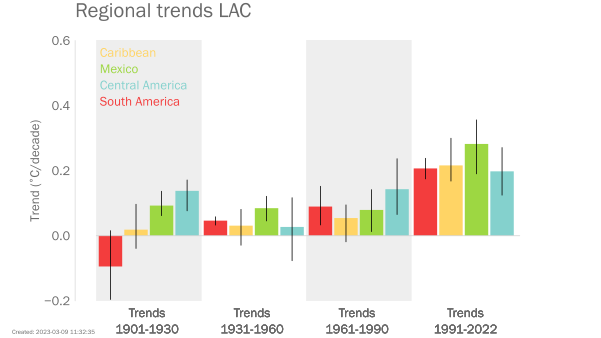Climate change vicious cycle spirals in Latin America and Caribbean

Temperatures over the past 30 years have warmed an average 0.2° Celsius per decade – the highest rate on record, according to the State of the Climate in Latin America and the Caribbean 2022 report. It highlights a vicious cycle of of spiraling impacts on countries and local communities.
Thus, for instance, prolonged drought led to a drop in hydroelectricity production in large parts of South America, prompting an upsurge in demand for fossil fuels in a region with major untapped potential for renewable energy.
Extreme heat combined with dry soils to fuel periods of record wildfires at the height of summer 2022, leading carbon dioxide emissions to spike to the highest levels in 20 years and thereby locking in even higher temperatures.
Glacier melt has worsened, threatening ecosystems and future water security for millions of people. There was a near total loss of snowpack in summer 2022 in the central Andean glaciers, with dirty and dark glaciers absorbing more solar radiation which in turn accelerated the melt.

“Tropical cyclones, heavy precipitation and flooding events, and severe multi-year droughts resulted in loss of life and billions in economic damages throughout 2022. Increasing sea-level rise and ocean warming pose increasing risks to coastal livelihoods, ecosystems and economies,” said WMO Secretary-General Prof. Petteri Taalas.
“Many of the extreme events were influenced by the long-running La Niña but also bore the hallmark of human-induced climate change. The newly arrived El Niño will turn up the heat and bring with it more extreme weather. Early Warnings for All will be vital to protect lives and livelihoods,” he said.
“The top priority areas for climate change adaptation and mitigation in the region are agriculture and food security, and energy. The report addresses these key topics, highlighting the impacts of the persistent droughts in the region on agricultural production and the unexploited potential of renewable energy, especially solar and wind resources,” said Prof. Taalas.
Latin America and the Caribbean has a high share of modern renewables in total final energy consumption, mainly because of hydropower. However, there is also the potential to tap into the region’s solar and wind resources, which accounted for only 16% of the total renewable generation in 2020.
Latin America and the Caribbean region plays a vital role in producing food and ecosystem services that benefit not only the region itself, but the entire planet. It is also highly vulnerable to climate risks because about three quarters of the population lives in informal urban settlements and about eight percent of the population is undernourished.
The report was released during an international Convention on Environment and Development , organized in La Havana, Cuba, and ahead of a Conference of Directors of Meteorological and Hydrological Services from Iberoamerica. It showcases the importance of National Meteorological and Hydrological Services and regional climate centres in providing enhanced services to support climate adaptation and mitigation.
It is the third such annual report for the region and provides decision-makers with regional and localized information to inform action. It is accompanied by an interactive Story Map.










